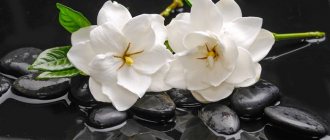Spathiphyllum (popularly known as “Women’s Happiness”) is a plant of the Araceae family.
This exotic flower takes root well in apartments and offices and is easy to care for. Dear readers!
For you, we have created communities on social networks in which useful articles and interesting ideas are published several times a day! Subscribe and receive useful content in a convenient format! The flower has large shiny leaves of rich green color and white inflorescences on a long stem.
In the wild it grows in the South American tropics and on the Philippine islands.
Caring for Women's Happiness after Purchase
For spathiphyllum to grow and bloom, it is necessary to create the right conditions and provide appropriate care. “Women's Happiness” loves lighted places or partial shade, room temperature and high humidity. It does not tolerate direct exposure to ultraviolet radiation and drafts.
Spathiphyllum feels best near eastern or western windows.
IMPORTANT! Having bought a flower in a store, it must be quarantined so that it gets used to its new microclimate. This will also protect other plants from possible infection by diseases and parasites.
Do I need to replant after purchase?
In the store, flowers are sold in small pots made of cheap thin plastic. This is done to save money. Moreover, sometimes instead of nutritious soil in stores, the flower grows in a special transport substrate. After watering, it thickens and stops allowing air to pass through to the roots. Because of this, they gradually begin to rot.
Thus, replanting a plant after purchasing and maintaining quarantine is necessary and is part of caring for women’s happiness.
First, you will inspect the root system of the flower. This will help identify diseases.
Secondly, spathiphyllum will grow in new nutrient soil. In this case, the soil will be loose enough so that the water does not stagnate in it and the roots do not rot.
Thirdly, you can choose the right size pot for the flower. This will further stimulate its growth.
Characteristics of spathiphyllum
The botanical name is formed by merging the Greek words "spata" and "phyllum". They mean a blanket and a leaf. The appearance of the flower confirms this.
Characteristic feature: stemless bush.
The bud resembles a leaf folded into a blanket.
The genus Spathiphyllum has 50 species. The historical homeland of the plant is the South American continent. Evolution has done its job, and the range has spread to Asia. In the wild it grows in damp forests, next to the riverbeds. Because of this, the root is not developed. Indeed, in a humid climate, the plant does not need to make its way to the water to depth. Leaves are oval-oblong. With a distinct “skeleton” of veins.
The flower is bisexual and produces smooth seeds after flowering.
Growing conditions and care features
Today, about five dozen varieties of spathiphyllum are known. About half is used for decorative purposes, and about 10 are suitable for home and office use.
Caring for spathiphyllum at home briefly:
- Lighting : bright, diffused. When located on the south side, shading is required.
- Temperature : +21+23 degrees Celsius.
- Humidity : high. Regular humidification from a spray bottle or an automatic humidifier is required.
- Location : ideally - eastern window sill. Place it on the south side in the back of the room.
- Feeding : 1-2 times a month. During the dormant period, do not feed.
- Watering : as the soil dries out. Do not allow water to stagnate in the pot.
- Transplant . The young plant is replanted annually. Then - once every 2-4 years.
- Reproduction : dividing the bush during transplantation or cuttings.
- Dormant period : October - February.
- Other : protect from drafts, select a pot according to size, regularly prune after flowering.
Spathiphyllum is unpretentious in care and growing conditions. It is able to grow even in a dark corner at low temperatures. Of course, in this case the plant gets sick more often and looks inconspicuous, with small leaves and pale flowers.
To achieve beautiful flowering of spathiphyllum, it needs to create the most comfortable home conditions.
Lighting at home
For proper care and growth, spathiphyllum must be provided with the necessary amount of light. But, at the same time, “Women’s Happiness” does not tolerate exposure to direct rays of the sun. Therefore, if you place a plant on the south side, it must be shaded.
Spathiphyllum can also develop in partial shade. But you should be careful here; poor lighting makes the leaves of the plant small. The inflorescences become pale and quickly fall off.
Temperature
Spathiphyllum loves warmth. The ideal temperature is about 23 degrees. Spathiphyllum is a hardy flower and can grow in both lower and higher temperatures. However, you should not subject the plant to tests, as the flower will begin to hurt.
Air humidity
Like a true resident of the tropics, spathiphyllum loves a humid climate. Therefore, if your apartment is dry, then you need to spray it with a spray bottle. During the summer months, it is advisable to do this in the morning and evening.
In addition, it is recommended to place a container with wet expanded clay or pebbles next to the pot.
You need to especially carefully monitor air humidity in winter and summer. During the cold season, heating devices operate to dry the air. In summer it is very hot, and moisture evaporates quickly in the sun.
Choosing a place to put the flower
Spathiphyllum must be protected from the harmful effects of the sun. If your windows face south, then it is best to place the plant in the back of the room. The best place for this exotic plant is near the eastern window. There the flower will have light, but it will not get sunburned.
What does a houseplant look like in the interior?
Spathiphyllum will add color to the interior of your room or office. At the same time, the flower does not look pretentious or vulgar.
The plant looks very beautiful on a light or, conversely, very dark background.
Some people prefer to place spathiphyllum in the bedroom at the head of the bed. Also popular is placement on low pedestals.
Tall varieties are placed directly on the floor.
You can also decorate the flower by placing containers with wet pebbles or decorative moss next to it.
Description of spathiphyllum, features of a houseplant
The name of the perennial, derived from two Greek words “spathi” and “phyllum”, means “bedspread”, “leaf”. I can't think of a more accurate "name". Bright green leaf plates of round or pointed shape carefully protect the flower, which does not have a stem, from the external environment.
The spathiphyllum plant belongs to the Araceae family, which has more than 40 species. The natives of this numerous “clan” are exotic flowers that are not inferior in beauty to the recognized favorites - saffron, orchid and some others.
The foliage and decorative representatives of the Araceae amaze with their unusual “painting” and richness of shades. For example, the leaf blades of the Domino and Picasso varieties are painted in bright, variegated colors.
Not all species are able to exist in modern apartments. Epiphytes that live on the surface of other plants need a natural environment. Some, like amorphophalus, lack space, others lack swampy lowlands.
Many owners who have studied the intricacies of the behavior of Women's Happiness have plants that bloom all year round. In classical descriptions of the flower, this period falls on April-June and September-November.
IMPORTANT! Few gardeners know that spathiphyllum is a poisonous plant. The leaves are dangerous. Therefore, when starting transplantation, you need to take care of rubber gloves. And also make sure that children and pets do not try to taste the plant.
Popular varieties of “Women’s happiness”
Chopin
Spathiphyllum Chopin
This plant variety is the result of selection. Chopin has a small height (about 35-40 cm) and is easy to care for. It has elongated leaf blades with clearly visible veins. The aroma is pleasant, but not cloying.
Vivaldi
Spathiphyllum Vivaldi
This variety is distinguished by a cream-colored inflorescence located on a high stalk. The leaves, unlike the Chopin variety, are more oval. The central vein is clearly visible. The rhizome is shortened.
Sensation
Spathiphyllum Sensation
Hybrid is distinguished by its high growth. With proper care, spathiphyllum “Sensation” can grow up to 150 cm. It has proportionate, large and expressive inflorescences.
Wallis
Spathiphyllum Wallis
This variety is considered the founder of many other varieties of spathiphyllum. It is not too tall, about 30-45 cm. The size of the inflorescence is about 3-5 cm. Among all varieties, it is considered the hardiest and most suitable for growing at home, one of the most unpretentious varieties to care for.
Cannofolia
Cannoleaf spathiphyllum
This variety is often used for breeding and is rarely found at home. The inflorescence is yellowish, the leaf blades are rich in color.
Verdi
Spathiphyllum Verdi
Variety Verdi grows up to 70 – 75 cm in height. It is distinguished by its snow-white inflorescence. Among all varieties of spathiphyllum, it requires special care conditions and is the most light- and heat-loving. The optimal temperature for growing is 25 - 27 degrees.
Domino
Spathiphyllum Domino
This hybrid blooms longer than others, with proper care. It also looks more advantageous thanks to the neat leaves, pointed at the end. It differs in appearance due to the randomly located stripes on the leaf plates. This feature gave the variety its name.
Picasso
Spathiphyllum Picasso
This variety is similar in appearance to "Domino", but the white stripes on its leaves are more often located. Moreover, some leaf blades are colorless. It is the result of breeding work with the “Wallis” variety.
What else is it called and is it correct to do so?
Women who are interested in the unusual properties of the flower may come across information that the plant is capable of driving men out of the house. This can provoke them, get rid of spathiphyllum.
This is connected with the teachings of Feng Shui, in which the plant is mistakenly called “Widow’s Tears”; this information terrifies the owners of the flower; many interpret the scientific name from Chinese in exactly this way, arguing that this flower should never be kept at home.
This is fundamentally incorrect; in fact, the name spathiphyllum comes from Greek and does not have a completely different meaning. The nickname “Widow's Tears” is given to the hoya flower, which is associated with a bad omen.
The “Women's Happiness” talisman flower is capable of creating real miracles - giving a lonely woman who dreams of marriage beautiful love and a good, caring husband. And the family, where there are often scandals and misunderstandings, will find peace and tranquility. You can believe in amulets and their magical properties, but do not forget that everything you want must be achieved.
If you find an error, please select a piece of text and press Ctrl+Enter.
When growing indoor flowers, and even planting flower beds in summer cottages, women often attach great importance to folk signs and superstitions and use various lunar calendars.
Who doesn’t want to get their well-deserved piece of female happiness with the help of a housekeeper and grow a beautiful plant, which also brings big and small home joys.
Conditions for flowering, or how to care for it to bloom
The flowering of spathiphyllum depends on the care conditions that are provided to it.
- Correct pot size. If the container is too small, the flower will have nowhere to grow. If it is too large, then the spathiphyllum will not bloom until its roots fill the entire volume.
- No drafts. From drafts, spathiphyllum gets sick and sheds its leaves. Therefore, if you open the windows for ventilation in winter, the plant must be moved to another place at this time.
- Correct temperature conditions. Women's happiness grows well at room temperature. If the thermometer shows less than 16 degrees for a long time, the flower will get sick and die. If, on the contrary, you place it in the scorching sun, the plant will simply “burn out.”
- Lack of nutrition. Spathiphyllum is fed 1-2 times a month. During the dormant period, it is better to stop feeding.
- Timely watering. Women's happiness should be watered as the soil dries out. Under no circumstances should water be allowed to stagnate in the pot. Because of this, the root system of the flower rots.
- Prevention of diseases and pests. Regular inspection of the flower will help prevent the development of fungal diseases and pests. If you do not want your spathiphyllum to disappear, carefully inspect the stems and leaves of the flower at least once every two weeks.
Sources
- Dorozhkina E.A. The influence of plants on the indoor microclimate and the human body // International scientific journal “Symbol of Science”, No. 4, 2015 https://cyberleninka.ru/article/n/vliyanie-rasteniy-na-mikroklimat-pomescheniy-i-organim-cheloveka/
- Plant taxonomy. Spathiphyllum // The Plant List https://www.theplantlist.org/1.1/browse/A/Araceae/Spathiphyllum/
- State catalog of pesticides and agrochemicals approved for use on the territory of the Russian Federation as of July 6, 2022 // Ministry of Agriculture of the Russian Federation https://mcx.gov.ru/ministry/departments/departament-rastenievodstva-mekhanizatsii-khimizatsii- i-zashchity-rasteniy/industry-information/info-gosudarstvennaya-usluga-po-gosudarstvennoy-registratsii-pestitsidov-i-agrokhimikatov/
Flower transplant
There is no need to replant Women's Happiness too often. While the flower is still young and growing, this can be done once a year. When the plant reaches its maturity, the frequency of transplants is reduced to once every 2-4 years.
Most often, spathiphyllum is transplanted using the transshipment method so as not to damage the roots.
But, if your pet is sick or has been in the same soil for too long, then when replanting it is better to clean the roots from the old soil. This method will also allow you to propagate spathiphyllum.
IMPORTANT! When replanting Women's Happiness, be sure to place drainage at the bottom of the pot.
Spathiphyllum transplant
How to transplant spathiphyllum at home?
Plant transplantation has been discussed from the very beginning of the article. It should be noted here that the root system of the presented flower is quite sensitive and susceptible to any mistakes made, in particular damage. Therefore, the transplant procedure after purchase or, if necessary, is carried out extremely carefully, observing all the features of proper reproduction and division.
Transplanting spathiphyllum to increase the volume of the pot is carried out once a year, in the spring before flowering. It is better to choose flowerpots that are shallow but oblong in shape, because the root system prefers to grow laterally rather than in depth.
The soil for spathiphyllum should be selected taking into account the features described above (preparation and composition of soil for propagation). Before planting, the soil can be treated with a weak solution of potassium permanganate. To root the plant, provide it with greenhouse conditions. Thus, the flower will quickly take root in the new pot and bloom with renewed vigor.
Indoor flowers that purify the air
Landing
When planting spathiphyllum, it is very important to choose the right pot size and soil. Women's happiness grows best in a mixture of peat, sand, turf, leaf soil and humus.
Before placing a flower in a new container, it is imperative to inspect the root system. Rotten and damaged roots are removed. Cuts and wounds are treated with a solution of potassium permanganate and sprinkled with crushed activated carbon.
Also, when planting spathiphyllum, it is recommended to trim off old leaves and peduncles. This is done so that the plant takes root better.
Helpful information
The flower is a herbaceous perennial. Spathiphyllum has no stem; the leaves begin to grow from a short rhizome and form a rosette. First, a petiole is formed, then it stretches out and becomes narrower towards the top, topped with a beautiful leaf. The height of the flower on average reaches 40 cm, but there are also meter-long giants.
“Women's happiness” grows quickly; in one season the rosette becomes twice as thick due to the large number of young leaves. In spring, tall and strong peduncles form from the axils. The flower has the shape of a spadix, wrapped on top with a white veil. Lasts up to 10 weeks, then turns green and dies. Flowering ends by mid-autumn, the plant goes dormant, but does not shed its leaves.
Reproduction
You can get several new young plants from one spathiphyllum in 3 ways:
- Seeds.
- By dividing the bush during transplantation.
- By cuttings.
The most effective way to propagate this plant is by dividing the bush. When you transplant a flower to a new place, you need to thin out the shoots. This can be done by dividing the rhizome into several parts. This way you will get 2-3 new plants that can be planted in separate pots.
The advantage of this method is that you get ready-made plants with a developed root system.
Reproduction of spathiphyllum
IMPORTANT! When dividing a spathiphyllum bush, be very careful. Be sure to treat damaged roots with potassium permanganate and crushed activated carbon.
Trimming
Spathiphyllum is pruned after flowering has ended. The old peduncle is removed, as well as yellowed or dried leaves of the plant. This procedure is carried out so that nutrients are not consumed on the faded peduncle.
Trimming is carried out with a stationery knife. This way the cut will be neat. By pruning with scissors, you damage the plant tissue, which can lead to infection. Sections must be treated with crushed activated carbon.
Pruning should be done as close to the root as possible.
Rejuvenation
Rejuvenation is important in the process of growing spathiphyllum. The fact is that over time the plant ages and loses its beauty.
The most effective way to rejuvenate a flower is to root a stem with aerial roots. The algorithm of actions is as follows:
- Select a stem with aerial roots.
- Cut the petioles from the stem so as not to damage the aerial roots. Please note that you need to cut off the petioles that are located below the leaf.
- Wrap the stem below the leaf rosette with a plastic sleeve.
- Make several ventilation holes in the sleeve.
- Moisturize periodically.
- After 50-60 days, roots will appear under the film.
- Cut the stem below the sleeve.
- Carefully remove the film so as not to damage the roots and plant the plant in the pot.
There is an easier way - cut off part of the stem with a rosette and place it in water until roots appear. When the roots grow to about 5 cm, the plant can be planted in a permanent place.
Inventory
Tools
Transplanting “female happiness” does not require any advanced equipment. Usually all the equipment required for the process can be found at home or in the garden.
So, to transplant a plant you will need:
- a garden watering can, preferably small in size;
- sprayer with clean water;
- drainage;
- special flower pot;
- soil mixture.
Priming
If you decide to purchase soil for transplanting “female happiness”, but do not know which one to choose, then it is recommended to give preference to mixtures for plants belonging to the Araceae family.
Pay attention to the composition; the mixture must contain:
- Earth;
- coarse sand;
- a small amount of peat;
- turf land;
- some wood ash or coal.
The acidity level of the mixture should be at a minimum level.
Pot
Which pot should spathiphyllum be transplanted into? An important component when choosing a pot for replanting is that it should be larger in size than the previous one. The material from which the pot is made must contain plastic
If spathiphyllum grows in a pot with a diameter of 18-20 cm, then you can already refuse replanting and simply update the top layer of the substrate from time to time.
It should be said that if you have a desire for the flower to begin to bloom immediately after transplantation, it is recommended to replant it in a narrow pot, smaller in diameter than the previous one.
Watering
The watering regime for spathiphyllum depends on the time of year. In spring and summer, during the period of growth and abundant flowering, watering should be regular and abundant. In autumn and winter – moderate.
IMPORTANT! At any time of the year, you need to water the plant only when at least the top layer of soil has dried out. Otherwise, the water will begin to stagnate. This will lead to rotting of the root system.
Spathiphyllum should be watered with settled water at room temperature. Ideally, filtration can also be carried out to remove harmful deposits.
Top dressing
Feeding Women's happiness is worth it in accordance with the time of year. During the cold season, apply fertilizers no more than once a month, and it is best to refrain from fertilizing at all.
In spring and summer, the amount of fertilizing increases, since more nutrients are consumed during the growth period. Therefore, at this time of year you need to feed the flower once every 2 weeks. This fertilizer application schedule continues until the end of flowering.
Spathiphyllum prefers organic fertilizers, but it perfectly accepts complex mineral fertilizers for flowers in diluted form.
Spathiphyllum and anthurium together
Very often, together with “women’s happiness” they put “men’s happiness”. These two plants look great together and complement each other perfectly.
Spathiphyllum blooms with beautiful white flowers, and anthurium will perfectly complement it with bright red colors.
“Women’s Happiness” is very popular among most flower growers, as it is unpretentious and easy to care for. It does not require any special skills in keeping indoor flowers. With proper watering and providing it with all the necessary conditions for 5-8 months a year, it will delight with its snow-white flowers and thick, bright foliage.
Diseases and pests
Spathiphyllum most often suffers from root rot, sooty fungus and late blight. All these are fungal diseases. They are dangerous because they spread very quickly throughout the plant and lead to its death.
If you notice that the leaves or stems of your pet have begun to turn black, then it is necessary to urgently treat it with a fungicide. In addition, the affected parts of the plant must be cut off and destroyed.
Spathiphyllum falls victim to the following pests:
- aphid;
- spider mite;
- scale insect;
- mealybug.
You can fight insects using insecticidal agents (for example, Fitoverma). You can also use tobacco infusion against aphids and scale insects. It is mixed with a soap solution and the stems and leaves of the plant are thoroughly treated.
To protect the flower from fungal diseases and pests, prevention should be included in the care of spathiphyllum. Preventive actions include: regular inspection of the plant, compliance with care rules, timely treatment with fungicides and insecticides.
It is important to remember that prevention is much easier than fighting for the life of an infected plant.
Sick spathiphyllum
IMPORTANT! If a flower is sick, it must be quarantined. In addition, it is necessary to conduct a preventive inspection of other plants.
How to resuscitate?
If your pet is not blooming, then there is a way to help him. But two conditions must be met:
- The flower should not be sick.
- The plant has not been recently replanted.
To make spathiphyllum bloom, it can be “shocked,” that is, placed in extreme conditions for a while. In an effort to survive, the plant will produce a flower.
To begin with, the pot with Women's Happiness is placed for 15 days in a cool place with a temperature of about 12 degrees.
After 2 weeks, the flower is returned to its usual place and a special liquid supplement (Uniflor-bud or Kemira Lux) or an extract from bird droppings is added.
IMPORTANT! Before purchasing fertilizer, make sure that the percentage of nitrogen in the fertilizer is less than the percentage of phosphorus and potassium.
After some time, the plant “shocked” in this way will begin to bloom. At this time, it is very important to maintain the required level of humidity in the room. Spray water regularly from a spray bottle or place containers of water near the plant.
When should we expect the first flowering?
It is worth understanding that the home flower “female happiness” enters the flowering phase only if the grower provides proper care. For example, the crop does not like being watered with cold water or placed in dark areas. In addition, too low a temperature in the spring (below 18 degrees) will provoke a long awakening of the plant after hibernation, as a result of which flowering may not occur at all.
“Women's happiness” blooms only in the warm season (from April to September). The chance that a flower will delight you with its decorative appearance can increase several times if you regularly fertilize the soil with mineral fertilizers. Particular attention should be paid to the content of phosphorus and potassium (nitrogen is necessary for the formation of green mass). Another very common reason why spathiphyllum does not bloom is that the pot is too narrow.
What signs and superstitions are there?
Spathiphyllum is popularly called Women's happiness. There is a belief that a girl who plants a flower in her house will quickly find a betrothed and get married.
In general, a large number of legends, superstitions and signs are associated with this flower.
For example, it is believed that spathiphyllum should only be bought on Wednesday, Friday or Saturday from a saleswoman with blond hair. At the same time, they give you a little more money and under no circumstances take change.
Another sign is associated with the flowering of the plant. If several flowers appear on the peduncle at the same time, then good luck awaits the family. If spathiphyllum does not bloom for a long time, then expect trouble.
It is also believed that spathiphyllum growing in the house has a positive effect on the health of a pregnant woman.
You can read more about the magical properties attributed to this flower in our article “Attracting “Women’s Happiness” with Spathiphyllum, all the signs and superstitions associated with the flower.”
What plants also bear this name?
Another representative of the Aroids is credited with the magical properties of attracting prosperity and happiness in love affairs. This is a beautiful Zamioculcas.
Zamioculcas zamifolia is a native of tropical Africa, the only one of its kind (monotypic species). The structure of the flowers is similar to spathiphyllum; the spathe is distinguished by a soft green color and a large inflorescence-cob.
It blooms rarely, but, according to signs, it possesses wonderful magic precisely during this period. It is believed to heal heart wounds and restore harmony in relationships. Also known as Dollar Tree.
Spathiphyllum brings joy and prosperity to the home. The discreet, non-flashy appearance of the exotic calms and discharges negative energy. And if you sincerely believe that this miracle flower brings happiness, then it will happen. After all, the Universe answers all our thoughts: “Yes!”
Common mistakes
Spathiphyllum is a tropical plant, and beginners in floriculture often make a number of mistakes when caring for and growing it.
- The biggest mistake is placing a flower in the sun . Women's happiness loves sunlight, but direct rays overheat the leaf plates. The plant begins to hurt. Therefore, in summer the flower is shaded.
- The second most common mistake is improper watering . You only need to pour water into a flower pot when the top layer of soil has dried out. In winter you need to water even less often. Therefore, before watering the flower, test the soil with your finger; if it is wet, then watering should be postponed.
- The third common mistake is an incorrectly selected pot when replanting . The new container should be only slightly larger than the previous one. The fact is that first of all, any plant tries to fill the space with roots and only then begins to develop the above-ground part. Therefore, if you plant Women’s Happiness in a container that is too large, you will wait a very long time for flowering.
- Untimely transplant . Like any indoor plant, spathiphyllum needs to be regularly replanted into a new pot. If this is not done, the flower stops growing.
- The temperature regime is not maintained . Women's happiness grows best at moderate temperatures and high humidity. The flower can develop for some time at low temperatures (about 16-18 degrees), but at the same time it becomes weaker and more susceptible to various diseases.
- Prevention of diseases and pests is not carried out . Inspecting the plant after watering will only take a few minutes, but will help you notice the sore in time. And the sooner you see that something is wrong with the flower, the greater the chance that it can be saved.
- Lack of fertilizing during flowering . Flowering is a very energy-intensive process that depletes the plant. Regular feeding will keep the flower healthy at home and prolong flowering.
Photo
Here you can see a photo of the crop during flowering, which was achieved by following all the rules of home care.
Answers to popular questions, or small secrets of success
Although spathiphyllum does not require extensive knowledge of floristry and is very easy to care for, many novice gardeners have a number of questions when growing this plant.
Why doesn't it grow well?
If the flower looks healthy, its leaves and stems are green without black, yellow or brown spots, then the reason for the poor growth of spathiphyllum is an excess of sunlight and moisture in the soil.
Another reason is the pot is too big. Until the root system develops properly, the green part of the flower will not grow.
If you accidentally “flooded” the spathiphyllum, then try loosening the soil. This will provide air access to the roots and allow the soil to dry out faster. If the soil remains wet for several days, then Women's Happiness will have to be transplanted into new soil.
Why does it wither?
There are several main reasons why spathiphyllum withers at home.
- A recent transplant is always stressful for the plant. It will take some time to get used to the new conditions. It is possible that some leaves will look wilted.
- Incorrect watering schedule . Wilting can also be caused by over- or under-watering. It’s much worse if you “flood” the flower. He will endure a mild drought and within a few days he will look healthy again. Excess moisture is dangerous because the earth clumps, air flow stops, and the roots begin to rot.
- Change of place. Women's happiness really doesn't like being moved from place to place. Changes in microclimate negatively affect primarily the leaf blades and peduncles, which begin to fade. Without a good reason, you should not rearrange the flower pot for a long time.
- Incorrect feeding regime. Beginning flower growers very often think that the more fertilizer they add, the more abundant the spathiphyllum will bloom. But this is a common mistake when caring for spathiphyllum. Excess minerals have a negative effect on the plant. In particular, processes of withering are observed.
- Pests. If you are sure that you have properly cared for your pet, pick up the leaves of the flower. Most likely, insects are breeding underneath them. They are removed from the leaf blades, and the bush itself is treated with insecticides and soap solution.
How often does it bloom?
Women's happiness blooms once per season. Most often - from March to the end of August - beginning of September. From October to February the flower should be at rest. To do this, it is pruned, watering and fertilizing are reduced.
You should not artificially achieve year-round flowering of spathiphyllum. The dormant period is very important for caring for the plant if you want it to delight you with lush flowers and live longer than a few years.
Constant flowering at home will quickly deplete a woman's happiness. It will become more vulnerable to fungal and bacterial diseases.
How to care for leaves
Spraying the flower
In spring and summer, spathiphyllum leaves are sprayed with a spray bottle and wiped with a damp cloth. This is done to increase the overall humidity, which this flower loves so much.
In autumn and winter, you should not spray the leaves with water, since the plant is dormant at this time of year. Just wipe the sheet plates with a dust cloth from time to time.
After Women's Happiness has faded, remove old, yellowed, wilted and dried leaves. This can be done while pruning the plant.
Why do the ends turn black?
If your spathiphyllum has blackened tips, it means you have overwatered the plant or applied too much fertilizer.
In this case, you need to stop watering and fertilizing for a while. The soil is loosened and dried. In the future, reduce the amount of fertilizer applied.
Why do flowers turn black?
The most common cause of blackening of the flowers of Women's Happiness is “wet hypothermia.” That is, when the plant is watered in the evening and remains standing on the window with the window open. The water does not have time to be completely absorbed, the temperature drops at night, and the roots of the plant become supercooled.
Saving women's happiness in this case can be very difficult. The plant will have to be moved to a warmer place, and the roots will have to be treated with Kornevin.
Also, blackening of flowers can signal a fungal disease. In this case, the plant is immediately quarantined and treated with fungicides with a thorough examination of the stems, leaves and roots.
Sometimes blackened flowers are the result of improper care. For example, non-compliance with watering and fertilizing regimes, too low a temperature, dry air.
How to increase the number of buds?
There are several tricks to increase the number of buds on spathiphyllum.
Firstly, there should be no old inflorescences on the plant. Therefore they will be deleted.
Secondly, the container with the flower is placed in a cold place for 15 days, and then returned back.
Thirdly, within a month it is fertilized twice with mineral fertilizers.
Fourthly, as soon as flowering begins, spathiphyllum is sprayed daily with warm water from a spray bottle. Be sure to do this carefully so as not to get on the buds.
What to do if spathiphyllum does not bloom?
“Why does spathiphyllum not bloom, but only produce leaves?” - a common question from most beginning gardeners.
Remember: the flower given in the description should always bloom, every spring. If the plant produces only leaves, it means that you are making some mistakes in growing a flower at home.
How to make spathiphyllum bloom? Follow these tips:
- The plant begins to bloom only if the root system has completely filled the volume of the pot. Therefore, it is extremely important to pay special attention to the choice of its volume. Choose products with the smallest difference in the larger direction.
- Flowering may not begin due to overwatering. It is important to follow the recommended frequency. As described above, overwatering is manifested by leaf rotting. They should be completely removed or only the rotten part should be cut off. Dry the soil to the required condition.
- How to care for it to bloom? – provide a suitable location. Make sure there is no shadow or direct sunlight. You should not place pots in a draft (on window sills, near doorways).
- Spathiphyllum can be “forced” to bloom. To do this, do not water the flower for a while, but do not allow the soil to become too dry, and then place the pot in a cool place for several days. You can put the plant on the balcony or veranda if the nights have already become warm. Then bring the flower back into the house to its usual place and wait patiently, continuing your usual care.
- Carry out a very unusual procedure carefully. Lightly rub the flower and pull it up by the leaves. Perhaps the plant lacks “space” and the usual air supply.
To determine why spathiphyllum does not bloom , lift the root system with soil. Check the soil for moisture. Perhaps due to poor drainage or small holes in the pot, moisture stagnates in the soil, which has already led to rotting of the roots.
By the way, look at the previous article. There is a lot of useful information for you - Caring for an orchid before and after flowering.
Dry the soil, waiting to water again. Otherwise, due to the lack of flowering, you will see characteristic yellowness and rotting of the leaves.
How to make spathiphyllum bloom? Video:
How I made my Spathiphyllum bloom
Spathiphyllum diseases
Like all indoor plants, spathiphyllum can “get sick”. Here are several common problems in growth and flowering, which include:
- Spathiphyllum leaves turn yellow. As described above, the yellowness of the leaves is due to excessive watering. But here you should take a close look at the structure and features of the yellowness presented. If the edges of the leaves turn yellow, it means that the novice gardener is making a mistake by watering the plant with unsettled water. Yellowing is also affected by the lack of light - the edges of the leaves may turn yellow and “give” a yellow web towards the middle.
- Why do spathiphyllum leaves turn black? The blackness of the leaves is already a consequence of the beginning of rotting of the tips. If at the initial stage of the problem the tips of the leaves turn brown with a characteristic yellowness, it means that there is excess moisture in the soil. Sometimes you can observe individual black spots on the surface of the leaf - this also indicates excessive watering.
- Why do the tips of spathiphyllum leaves dry out? The tips of the leaves dry out due to lack of moisture due to lack of watering, as well as due to exposure to dry air. As already noted, the flower must be sprayed regularly or a container of water placed nearby.
- Why do spathiphyllum flowers turn green? The greening of a plant's flower cover is a natural process and signals the end of flowering. As soon as you notice that all the flowers have acquired the appropriate green color, you can cut them yourself or leave them until they fall. The leaves can also be processed if necessary (if there are dried areas).
- If the green color of the bedspread formed somewhat earlier than expected (the end of flowering occurs at the end of summer - beginning of autumn), it means that there is an excess nitrogen content in the soil. Another reason may be high indoor temperatures. Check both the premises to eradicate the problem. Try changing the fertilizer if it contains nitrogen.
- Sometimes you can observe a sad picture in the form of a leaf that is not fully opened. Such unpleasant phenomena are associated with the density of the soil. That is, when transplanting it, it was laid quite tightly, so that now the root system lacks natural air circulation. Pick up the entire flower and loosen the soil using a special tool for indoor plants.
All of the listed unpleasant phenomena in the growth and flowering of a plant are associated with mistakes made by the grower. To return the spathiphyllum to its normal state, try to eradicate the problem by replanting it in new soil.
Please take a look at the following article. It contains more useful information - Anthurium: care at home (flower of male happiness).
But it is necessary to warn that, despite the certain benefits of the proposed actions, it is better to refuse to replant the plant during the flowering period.
The root system is even more vulnerable during the flowering period than during dormancy. Therefore, wait a moment and use slightly different methods to eliminate troubles.
Spathiphyllum: problems and their solutions. How to make Spathiphyllum bloom











